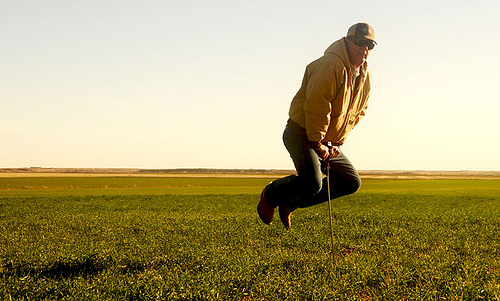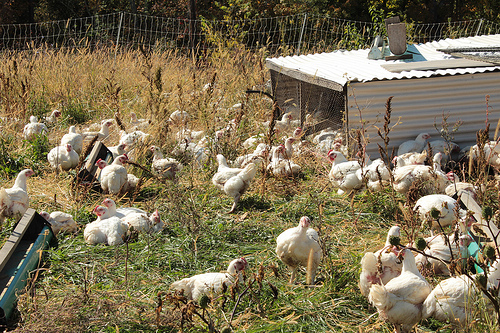
Even though he is putting his entire weight on it, Henderson’s soil pressure probe cannot penetrate the surface of the soil under his neighbor’s dryland wheat crop, which has been farmed with conventional plowing methods.
Clay County, Texas farmer Tommy Henderson may not know everything about farming, but he’s got more than the basics covered—even during a historic drought. Read more »
USDA is committed to fostering a clean energy economy and to improving the environment by conducting operations in a sustainable and environmentally responsible manner, complying with environmental laws and regulations, and leading by example. In order to fulfill its mission of providing leadership on food, agriculture, natural resources, rural development, nutrition, and related issues, USDA focuses on the future. The Department recognizes the significance of global climate change and how potential impacts such as more frequent or severe weather events can affect our programs and operations.
To better coordinate USDA’s sustainability efforts and build on past success, USDA has prepared its 2012 Strategic Sustainability Performance Plan that underscores strategies and goals to save taxpayer dollars, reduce carbon emissions, cut waste and save energy. As part of this effort, this year we have also prepared a Climate Change Adaptation Plan that outlines how the Department will address the impacts of climate change on its key mission areas such as agricultural production, food security, rural development, and forestry and natural resources conservation. The plan is available and open for a 60-day public comment period.
The USDA Climate Change Adaptation Plan includes input from eleven USDA agencies and offices. It provides a detailed vulnerability assessment, reviews the elements of USDA’s mission that are at risk from climate change, and provides specific actions and steps being taken to build resilience to climate change. The plan advances President Obama’s efforts to prepare the federal government for climate change. We expect to revise and update the plan in 2013 in response to comments received from the public. Read more »

LESA/LEPA system on Gonzales’ alfalfa field
Joseph and Jeremy Gonzales are doing something different with their Gonzales Land and Cattle operation in Lovington, N.M., and it’s hard not to notice. Farming is hard enough without adding extra challenges. So the Gonzales brothers are using 21st-century technology to work smarter, not harder. Read more »

Scott County Indiana Muscatatuck River Bottoms, March 5-2007. Photo credit Mark Trabue.
A wetland restoration project completed by USDA’s Natural Resources Conservation Service in Kentucky has attracted the fancy of a pair of endangered whooping cranes.
In early November, a pair of whooping cranes were discovered on a property in western Kentucky that was recently restoredwith NRCS’ help. The restoration to bottomland hardwood wetlands included tree planting and the creation of shallow water areas for migratory wildlife on nearly 900 acres of former cropland that was put into a conservation easement. Read more »

A member of the Mississippi Band of Choctaw Indians removes the kernels from a corn of cob, one step in the hominy-making process.
For special meals like those on birthdays and Christmas, members of the Mississippi Band of Choctaw Indians include hominy on the menu—but hominy, essentially dried corn kernels, is expensive to purchase. Read more »

The free range meat chickens stay in their shelters to protect them from predators. Electric netting in combination with the dogs protects them. A drip line on each shelter allows for a garden hose to be connected in order to supply fresh water for the chickens in their shelter.
Over a decade ago, Winston and Teresa Pike brought their family back to the 140-acre farm where Winston grew up to begin a farming operation of their own.
Since then, the Pikes’ business has grown from a small family farm with fewer than ten pasture-fed beef cattle to a thriving operation with over 100 head of beef cattle, as well as dairy cows, hogs, meat chickens, egg laying chickens and turkeys – not to mention a variety of vegetables. The farm sells its organic products to restaurants, a co-op and online, and has a CSA (community-supported agriculture, a kind of farm subscription service). Read more »





